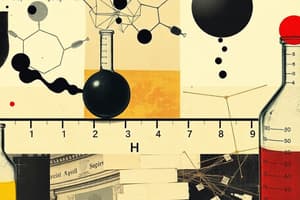Podcast
Questions and Answers
Which of the following describes an indicator?
Which of the following describes an indicator?
- A substance that reacts with metals to produce hydrogen gas.
- A substance always tastes sour.
- A substance with a pH of 7.
- A substance that changes color depending on the acidity or basicity of a solution. (correct)
Litmus paper will turn red in a basic solution.
Litmus paper will turn red in a basic solution.
False (B)
What color does phenolphthalein turn in a basic solution?
What color does phenolphthalein turn in a basic solution?
pink
A ______ is a mixture of different indicators showing different colors for different pH ranges.
A ______ is a mixture of different indicators showing different colors for different pH ranges.
Match each indicator with its behavior in an acidic or basic solution.
Match each indicator with its behavior in an acidic or basic solution.
Flashcards
Acids
Acids
Substances that release hydrogen ions (H+) in water, having a sour taste.
Bases
Bases
Substances that release hydroxide ions (OH-) in water, having a bitter taste and soapy feel.
Neutral
Neutral
A substance that is neither acidic nor basic, with a pH of 7.
pH Scale
pH Scale
Signup and view all the flashcards
Indicators
Indicators
Signup and view all the flashcards
Study Notes
Acids (Acidity)
- Acids are substances with a sour taste.
- They react with certain metals, producing hydrogen gas.
- Acids release hydrogen ions (H+) when dissolved in water.
- Greater hydrogen ion concentration signifies greater acidity.
- Examples include lemon juice, vinegar, and battery acid.
- Acids can damage metals and some fabrics.
- Strong acids cause severe burns.
- Acids are used in industrial processes like manufacturing and cleaning.
- The pH scale measures acidity and basicity.
Bases (Bascicity)
- Bases have a bitter taste and soapy feel.
- They react with acids to neutralize them, forming water and a salt.
- Bases release hydroxide ions (OH-) when dissolved in water.
- Greater hydroxide ion concentration signifies greater basicity.
- Examples include soap, baking soda, and ammonia.
- Bases can be corrosive, especially strong bases.
- Bases are used in cleaning products, fertilizers, and other applications.
Neutral
- Neutral substances are neither acidic nor basic.
- Pure water is neutral.
- A neutral substance has a pH of 7.
Indicators
- Indicators change color in acidic or basic solutions.
- They determine acidity or basicity.
- Litmus paper: Red turns blue in a base; blue turns red in an acid.
- Other indicators include phenolphthalein (colorless in acid, pink in base) and universal indicator (various colors for different pH ranges).
- Indicators change color at specific pH values, indicating the degree of acidity or basicity.
Studying That Suits You
Use AI to generate personalized quizzes and flashcards to suit your learning preferences.



